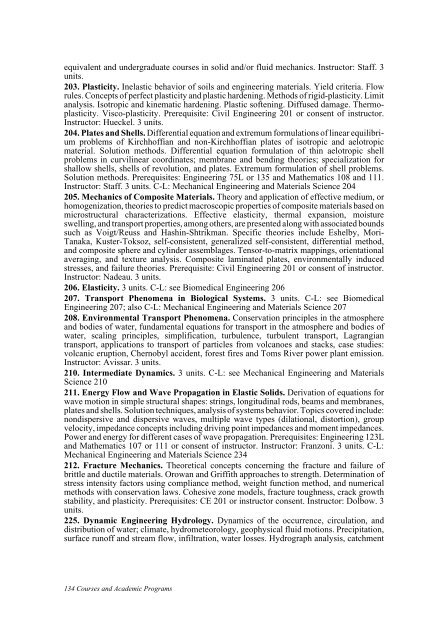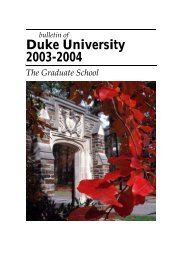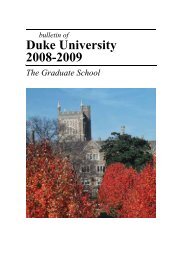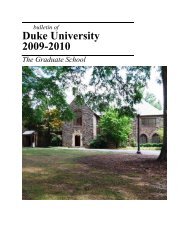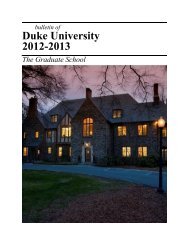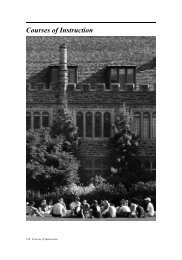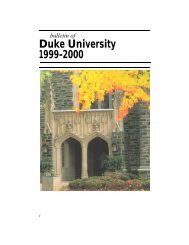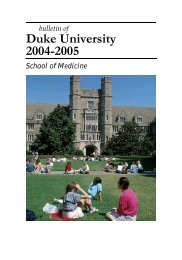2005-06 - Office of the Registrar - Duke University
2005-06 - Office of the Registrar - Duke University
2005-06 - Office of the Registrar - Duke University
You also want an ePaper? Increase the reach of your titles
YUMPU automatically turns print PDFs into web optimized ePapers that Google loves.
equivalent and undergraduate courses in solid and/or fluid mechanics. Instructor: Staff. 3<br />
units.<br />
203. Plasticity. Inelastic behavior <strong>of</strong> soils and engineering materials. Yield criteria. Flow<br />
rules. Concepts <strong>of</strong> perfect plasticity and plastic hardening. Methods <strong>of</strong> rigid-plasticity. Limit<br />
analysis. Isotropic and kinematic hardening. Plastic s<strong>of</strong>tening. Diffused damage. Thermoplasticity.<br />
Visco-plasticity. Prerequisite: Civil Engineering 201 or consent <strong>of</strong> instructor.<br />
Instructor: Hueckel. 3 units.<br />
204. Plates and Shells. Differential equation and extremum formulations <strong>of</strong> linear equilibrium<br />
problems <strong>of</strong> Kirchh<strong>of</strong>fian and non-Kirchh<strong>of</strong>fian plates <strong>of</strong> isotropic and aelotropic<br />
material. Solution methods. Differential equation formulation <strong>of</strong> thin aelotropic shell<br />
problems in curvilinear coordinates; membrane and bending <strong>the</strong>ories; specialization for<br />
shallow shells, shells <strong>of</strong> revolution, and plates. Extremum formulation <strong>of</strong> shell problems.<br />
Solution methods. Prerequisites: Engineering 75L or 135 and Ma<strong>the</strong>matics 108 and 111.<br />
Instructor: Staff. 3 units. C-L: Mechanical Engineering and Materials Science 204<br />
205. Mechanics <strong>of</strong> Composite Materials. Theory and application <strong>of</strong> effective medium, or<br />
homogenization, <strong>the</strong>ories to predict macroscopic properties <strong>of</strong> composite materials based on<br />
microstructural characterizations. Effective elasticity, <strong>the</strong>rmal expansion, moisture<br />
swelling, and transport properties, among o<strong>the</strong>rs, are presented along with associated bounds<br />
such as Voigt/Reuss and Hashin-Shtrikman. Specific <strong>the</strong>ories include Eshelby, Mori-<br />
Tanaka, Kuster-Toksoz, self-consistent, generalized self-consistent, differential method,<br />
and composite sphere and cylinder assemblages. Tensor-to-matrix mappings, orientational<br />
averaging, and texture analysis. Composite laminated plates, environmentally induced<br />
stresses, and failure <strong>the</strong>ories. Prerequisite: Civil Engineering 201 or consent <strong>of</strong> instructor.<br />
Instructor: Nadeau. 3 units.<br />
2<strong>06</strong>. Elasticity. 3 units. C-L: see Biomedical Engineering 2<strong>06</strong><br />
207. Transport Phenomena in Biological Systems. 3 units. C-L: see Biomedical<br />
Engineering 207; also C-L: Mechanical Engineering and Materials Science 207<br />
208. Environmental Transport Phenomena. Conservation principles in <strong>the</strong> atmosphere<br />
and bodies <strong>of</strong> water, fundamental equations for transport in <strong>the</strong> atmosphere and bodies <strong>of</strong><br />
water, scaling principles, simplification, turbulence, turbulent transport, Lagrangian<br />
transport, applications to transport <strong>of</strong> particles from volcanoes and stacks, case studies:<br />
volcanic eruption, Chernobyl accident, forest fires and Toms River power plant emission.<br />
Instructor: Avissar. 3 units.<br />
210. Intermediate Dynamics. 3 units. C-L: see Mechanical Engineering and Materials<br />
Science 210<br />
211. Energy Flow and Wave Propagation in Elastic Solids. Derivation <strong>of</strong> equations for<br />
wave motion in simple structural shapes: strings, longitudinal rods, beams and membranes,<br />
plates and shells. Solution techniques, analysis <strong>of</strong> systems behavior. Topics covered include:<br />
nondispersive and dispersive waves, multiple wave types (dilational, distortion), group<br />
velocity, impedance concepts including driving point impedances and moment impedances.<br />
Power and energy for different cases <strong>of</strong> wave propagation. Prerequisites: Engineering 123L<br />
and Ma<strong>the</strong>matics 107 or 111 or consent <strong>of</strong> instructor. Instructor: Franzoni. 3 units. C-L:<br />
Mechanical Engineering and Materials Science 234<br />
212. Fracture Mechanics. Theoretical concepts concerning <strong>the</strong> fracture and failure <strong>of</strong><br />
brittle and ductile materials. Orowan and Griffith approaches to strength. Determination <strong>of</strong><br />
stress intensity factors using compliance method, weight function method, and numerical<br />
methods with conservation laws. Cohesive zone models, fracture toughness, crack growth<br />
stability, and plasticity. Prerequisites: CE 201 or instructor consent. Instructor: Dolbow. 3<br />
units.<br />
225. Dynamic Engineering Hydrology. Dynamics <strong>of</strong> <strong>the</strong> occurrence, circulation, and<br />
distribution <strong>of</strong> water; climate, hydrometeorology, geophysical fluid motions. Precipitation,<br />
surface run<strong>of</strong>f and stream flow, infiltration, water losses. Hydrograph analysis, catchment<br />
134 Courses and Academic Programs


